People tend to hear what they want to hear and believe what they need to believe. In no place is this more true than on Wall Street. The Federal Reserve has made abundantly clear that it will tighten monetary policy until inflation is virtually vanquished. And yet, those who have no choice but to be nearly fully invested at all times have completely ignored this fact and were left trying to convince the investing public not to believe their own ears. That was a huge mistake going into the start of this year, and that is even more true today. The Federal Open Market Committee, the policy-making arm of the Fed, is telling us that rates will increase to about 4 percent by early 2023, but overly optimistic observes still say the Fed is bluffing.

Dreamstime
Commentary




